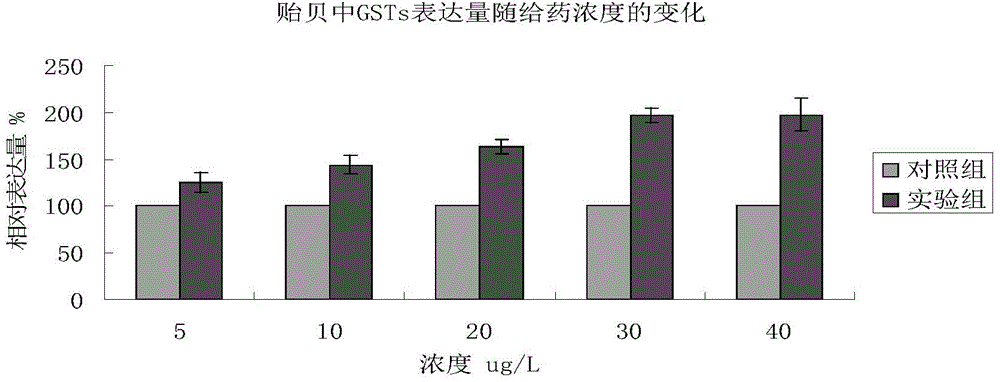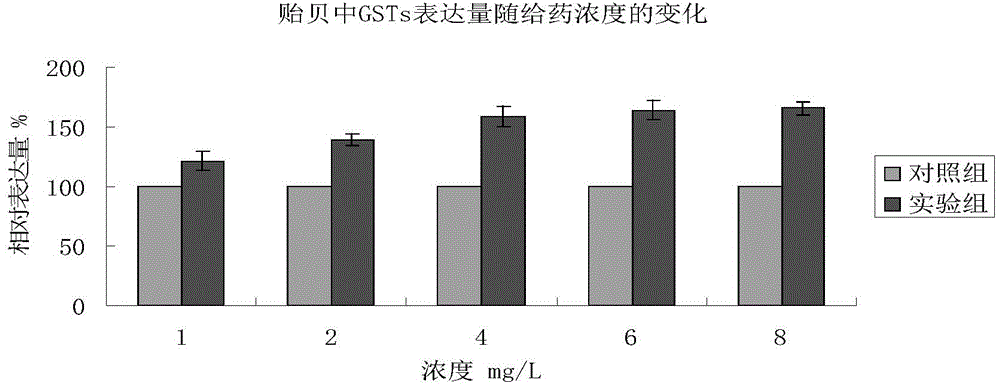Method for detecting contaminants in water employing mussel
A technology for pollutants and mussels, applied in biochemical equipment and methods, microbial determination/inspection, DNA/RNA fragments, etc., can solve the problems of missed detection, undetectable secondary metabolites, etc. The effect of reducing the inspection time and reducing the inspection cost
- Summary
- Abstract
- Description
- Claims
- Application Information
AI Technical Summary
Problems solved by technology
Method used
Image
Examples
Embodiment 1
[0022] 1. Extract RNA from mussel liver tissue, and then use the extracted RNA as a template to synthesize cDNA by reverse transcription;
[0023] Material:
[0024] Mussel liver; RNA extraction kit, RNAprep pure Tissue Kit, Tiangen; reverse transcription Prime Script RT kit: TaKaRa, Japan; pipette; disposable syringe; square plate; tweezers; surgical scissors; Petri dish; 1.5mL Centrifuge tube.
[0025] Reagent material
[0026] 95% RNase-free ethanol; 0.1% DEPC treated water; SV RNA Lysis Buffer; SV RNA dilution Buffer; SV RNA Wash Solution; Yellow core Buffer; MnCl 2 0.09M; DNase Ⅰ; SV DNase Stop Solution; Nuclease-Free water; agarose; 10×TAE electrophoresis buffer (40m MTris, 20mM NaAc, 1mM EDTA pH 8.0); carrier buffer (0.25% bromophenol blue, 30% glycerol); ethidium bromide aqueous solution (10 mg / mL).
[0027] Since RNA is easily degraded, RNase contamination should be strictly prevented during the entire extraction process. Samples such as glass containers and EP t...
Embodiment 2
[0084] Embodiment 2 detects to malachite green
[0085] Malachite green has side effects such as high toxin, high residue, carcinogenicity, teratogenicity, and mutagenesis. It can remain in animals for a long time. After entering the body of humans and animals through metabolism, it can be transformed into fat-soluble colorless Malachite green is a serious hazard to human health. Many countries have listed malachite green as a banned drug in aquaculture. In 1992, Canada banned it as a fungicide in fisheries. The United States stipulates that malachite green and colorless malachite green are prohibited from being detected in edible aquatic products. In June 2002, the European Union issued a decree to ban the use of malachite green in fisheries. The British Food Standards Agency believes that malachite green is a chemical agent that has great side effects on the human body. Any fish is not allowed to contain this kind of substance, and this chemical substance should not appea...
Embodiment 3
[0089] Example 3: Detection of exposure to deltamethrin
[0090] Pyrethroid pesticides represented by deltamethrin are highly toxic to fish. Therefore, there are relevant regulations in my country that prohibit the use of pyrethroid pesticides in paddy fields. The environment is inevitably affected and harmed by pesticides, causing pollution to aquatic products.
[0091] When mussels were exposed to deltamethrin at different concentrations of 1, 2, 4, 6 and 8 mg / L, the relative expression of GSTs increased sharply within 72 hours, and the expression increased slowly and relatively stable after 72 hours, possibly in Under the induction of deltamethrin, the combination of the enzyme and the substrate began to become saturated.
[0092] In this example, the situation of its GSTs gene transcription and expression was compared with the results of detection of deltamethrin content by gas chromatography mass spectrometry.
[0093] At the concentration of 1mg / L deltamethrin, the expres...
PUM
 Login to View More
Login to View More Abstract
Description
Claims
Application Information
 Login to View More
Login to View More - R&D
- Intellectual Property
- Life Sciences
- Materials
- Tech Scout
- Unparalleled Data Quality
- Higher Quality Content
- 60% Fewer Hallucinations
Browse by: Latest US Patents, China's latest patents, Technical Efficacy Thesaurus, Application Domain, Technology Topic, Popular Technical Reports.
© 2025 PatSnap. All rights reserved.Legal|Privacy policy|Modern Slavery Act Transparency Statement|Sitemap|About US| Contact US: help@patsnap.com



